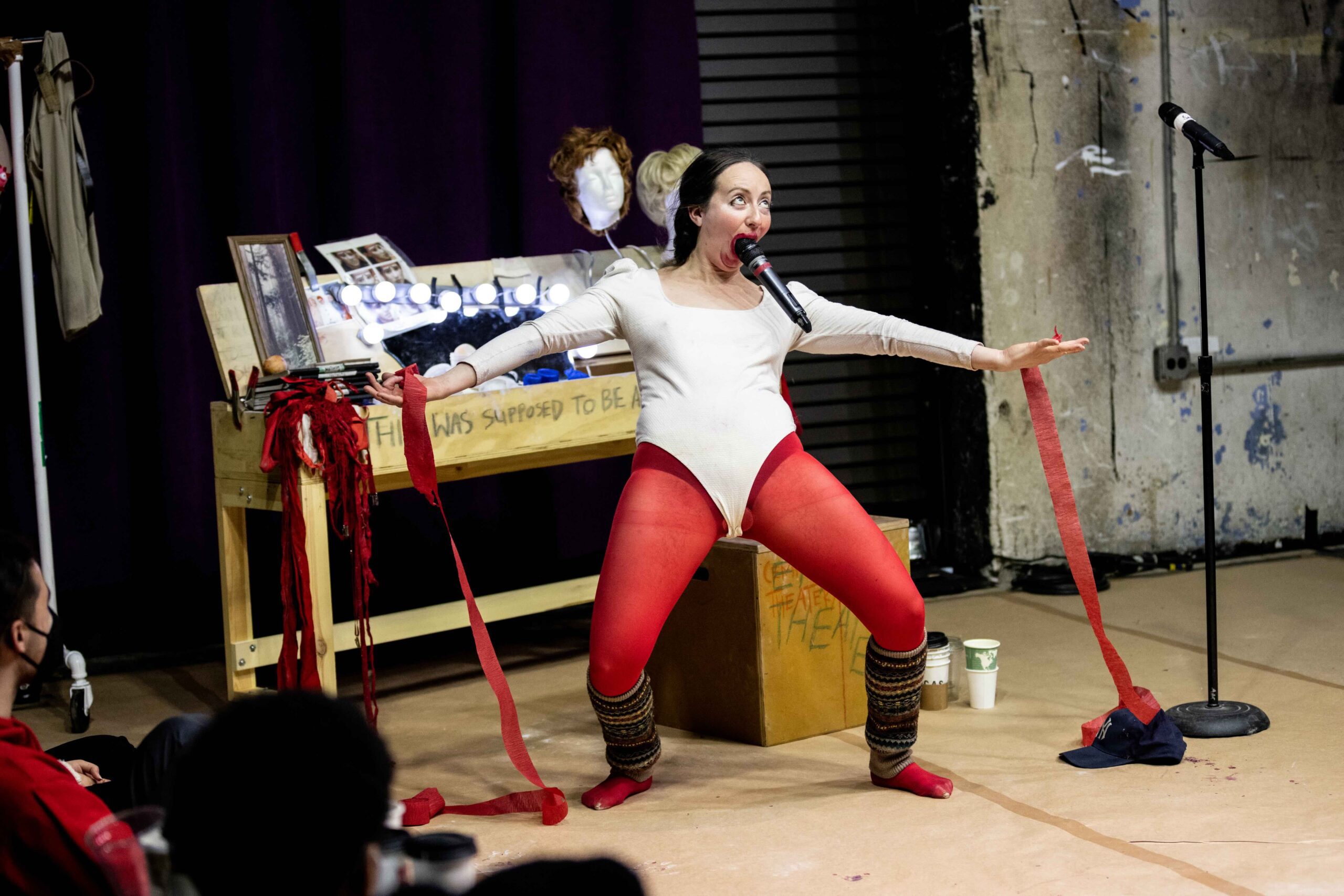Filip Vest interviews fellow performance artist Alex Tatarsky about clowning as a response to the state of the world, allowing porousness in your work, the futility of institutional critique and the discomfort of puns.
I meet the artist Alex Tatarsky at a cute, packed luncheonette in the East Village of Manhattan in between both of our packed programs at Under the Radar Festival. Tatarsky has just finished their last showing of the work in progress Nothing Doing. You can read my article about the festival here.
FILIP VEST [FV]: I first discovered your work in 2023 when I saw Sad Boys in Harpy Land, I’d been told that I had to go to and see it. It was totally sold out, but I managed to get a spot, and I was totally blown away, also because I think we have lot in common in our way of working. There are so many things I’d like to talk about, but maybe you could start telling me a bit about your background. I understand that you’re actually a trained clown?
ALEX TATARSKY [AT]: Yeah, I grew up in this neighborhood in New York City and I think my first and probably main influences are local performers. There’s a very rich scene here of weirdos: club performers, comics and street performers. So, I was basically just hanging out in the parks all the time, falling in love with various street performers and the way that they can both attract a huge crowd, hold them captive, collect tips and also make fun of every single person no matter their background. It’s a beautiful skill, the equalizing power of humor and this vaudevillian tradition of how to speak to a big crowd. So, for many years I was just making shows and touring them by myself and at some point, I thought: “Should I study this?”. But I didn’t know where to go, because I didn’t know exactly what it was. I eventually met this Irish Marxist clown named Ed Malone and he watched me perform and he was like: “You’re a clown,” which was not a word I thought of before. Through that I began studying mask performance and then I went eventually to study at a school started by Pig Iron Theater Company based in Lecoq physical theater pedagogy and then integrated that with this downtown New York street performance weird stuff.
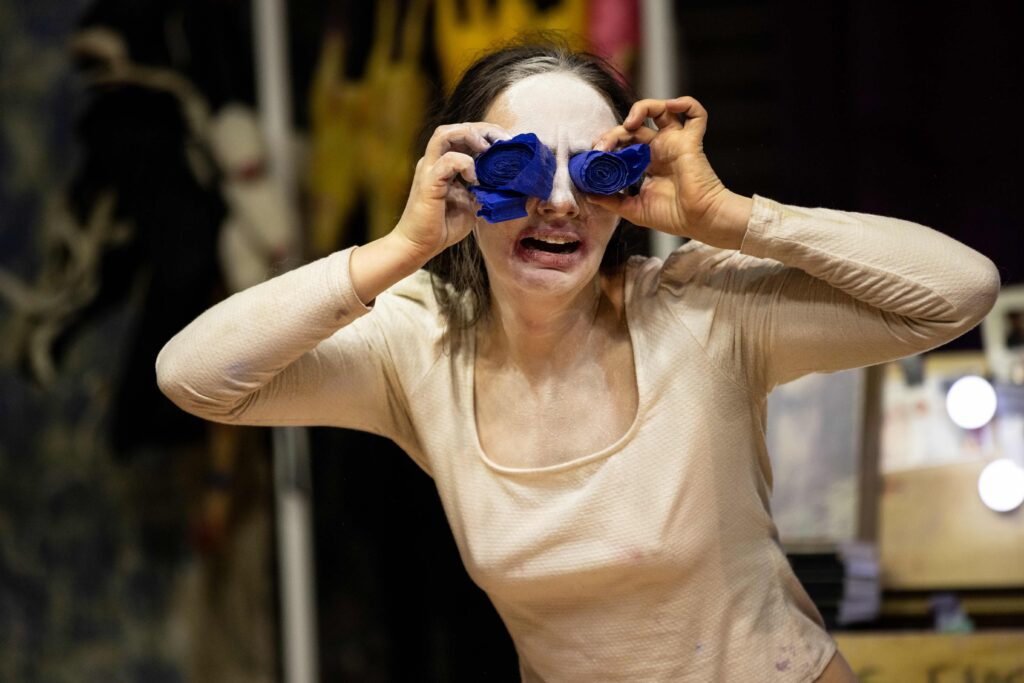
FV: So how do you think about genres in your work? What would you call what you do?
AT: I use the word clowning to describe my work because clowning draws from theatre, it draws from dance and movement practice. You can put anything you want in it. It can draw from performance art, visual language, there can be music. Clowning is more about a relationship to the audience. For me clowning just means that I acknowledge that the audience is there, and I respond to them… and they respond to me. And we make the piece together.
FV: You’re talking about being inspired by street performers and engaging people, but how does the relationship with the audience feel when you perform inside art institutions?
AT: It often feels really bad… (laughs) God bless these institutions for programming me, but performing in visual art contexts can be tricky. Because an art crowd often comes in with their brains, not their heart and their body. So, they have this very arm crossed, very intellectual approach to it. They don’t wanna laugh. They don’t know if they’re allowed to laugh. They don’t wanna be made a fool of and they also don’t wanna watch someone else making a fool of themself. The whole thing is just too embarrassing. So, I find those contexts both difficult and also really interesting, because there are so many power dynamics to think about. In an art setting, I have a heightened attention to the life of objects as well as questions of value and labor. So, it’s also been very generative. I made a show at The Whitney Museum over the summer, and I did a show at Moma PS1. It’s very interesting for me to engage with those contexts even though often – even architecturally – it feels quite brutal. But I love observing people in these spaces and just mirroring them back to them. And then often you can break open whatever is happening and play with it.
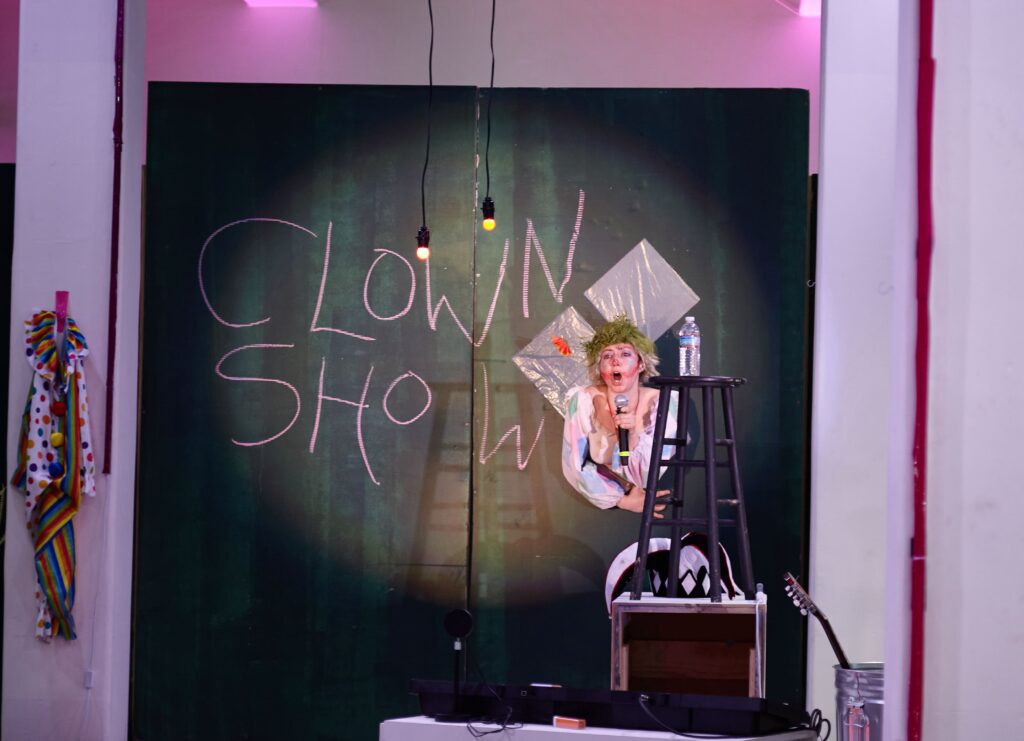
FV: I was talking to a dancer the other day who said that a lot of her colleagues want to take clowning classes now. Why do you think clowning is getting so popular?
AT: I began noticing this at least in a US context back in 2016, when Trump was first elected, and I made a whole show tracing the connections between the circus and the ‘political circus’ in an American context. Political campaigns here followed the same trail laid out by the first American circuses, because they all followed the railroad. I think there’s a very close relationship between mass entertainment and mass politics in America. In all the imagery in the mainstream media, Trump was always depicted as a clown. I was just graduating from clown school at that time, and I developed this obsession with clowns becoming a central metaphor in our culture. It was the language that people began using to make sense of this topsy-turvy feeling of fools in power. So, I think in many disciplines people are now turning to clowns to understand what’s going on.
FV: But if the king turns into the jester, where does that leave the role of the jester? Who’s the jester to the jester-king?
AT: It’s very confusing… (laughs) At least in a US context, the problem here is that we have people in power pretending to be the outsiders. Billionaires pretending to represent the working class and be outside the political elite. So, they’re pretending to be this clown outsider figure, but really they’re not. I get mad at them because they’re pretending to be clowns.
FV: They’re appropriating clowning!
AT: They’re appropriating clowning, totally! (laughs)
FV: Politics do seem to play a big role in your work. Even when you’re running around as this manic clown character inside some sort of surreal universe, the outside world always seems to seep in. How do you see the relationship between your work and the political landscape that you’re in?
AT: It’s interesting you use the language of things seeping in, because I’ve been thinking a lot about leakiness as a metaphor and approach to making stuff: “How can I let things pour into me?”. So, it’s not about me, my individual self, generating material, it’s more about letting things in. Because I think so much of surviving right now can mean cutting yourself off emotionally from things in order to get through the day because it’s too unbearable what’s happening in the world. So at least in the space of performance, I’m thinking: “Ok, we have an hour or so, where we can let things in.” And that kind of porousness is really guiding me right now. It also naturally becomes a way of thinking about borders. All borders are fictional. Borders between genres, between nations and so on. We should recognize and celebrate porousness in relation to borders. The borders of ourselves and the borders of our invented nation-states.
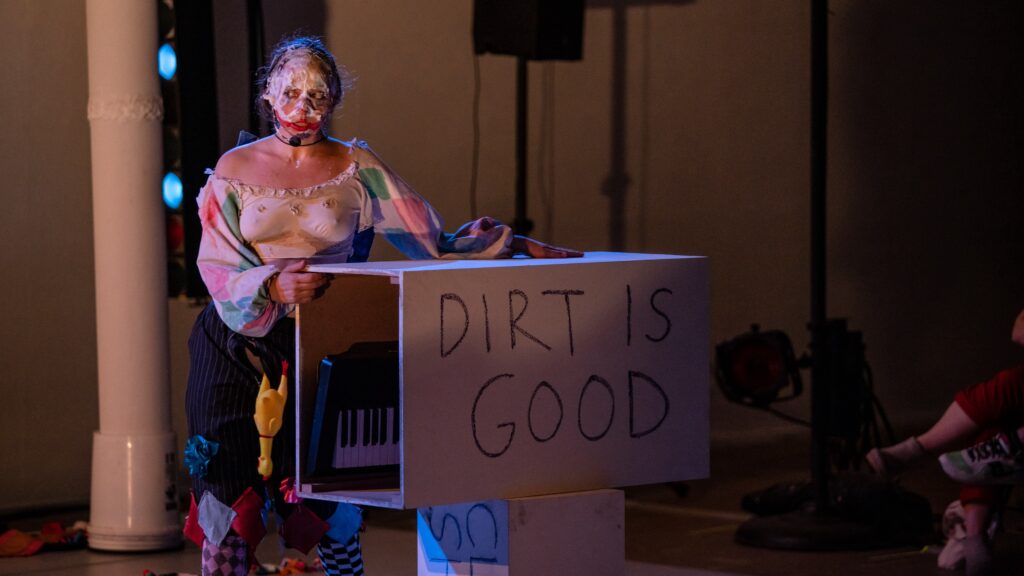
FV: There’s a line from your work in progress Nothing Doing, that’s been stuck in my head since I saw the show. It’s this character that’s talking about being right in the middle of a joke, where people don’t know yet where it’s going and if it’s going to be funny – and how scary and precarious that space is. Maybe I’m reading too much into it, but that moment, in the middle of the joke and the awkwardness and vulnerability of that, is that something you feel like relates to your work in general?
AT: I’ve been thinking a lot about the middle as a concept. Because I think this moment, we’re in globally is a sort of middle, where we don’t know exactly what’s coming. And we don’t yet have the language to understand where we are in history. Things can go many ways and there’s a great sense of foreboding as regards the real increase in right wing conservatism around the world. This feeling of: “How do we navigate a moment we don’t fully understand yet?” Because what is to come, hasn’t happened yet. And actually, we can shape how this turns out. But we’re in the middle of it. So, there’s a lack of clarity.
FV: We’re still waiting for the punchline…
AT: Exactly. And maybe we can change it.
FV: I personally am obsessed with jokes that are too long. My dad is really good at telling those. Like when you have too much context and background for the characters or setting and the setup feels so long in relation to the actual punchline. I think I like that it becomes more about this whole worldbuilding and characters and all those things, that are also part of telling jokes.
AT: Hearing you say that it makes me think about wandering, which is something I reflect upon a lot. Like diaspora and journeys that aren’t about getting to a destination. Journeys that aren’t about arriving and claiming a particular territory but about refusing to arrive and refusing to claim territory. I really believe in staying in that place before arrival, where it’s not about ownership or finishing or completion but rather the aim is to stay attuned to the present.
FV: And how does that wandering look in the workroom? For example, when you were making Nothing Doing?
AT: That project in particular was a very short process and very vulnerable. Because I like to think about things for many years and this was two weeks of thinking. Every night I made such interesting discoveries. So, the wandering or the searching was happening a lot with the audience in the space. And that’s where most of the work happens. Typically in a longer process that might be a few years, for me it’s just about performing really regularly. I don’t make much stuff outside of gigs. So, I just set up lots of gigs and then make stuff for those gigs and try it out and something starts to take shape over time. The audience helps me know what it is. When I’m alone in the room I genuinely don’t know if something is funny or tragic or boring or alive. I just don’t know.
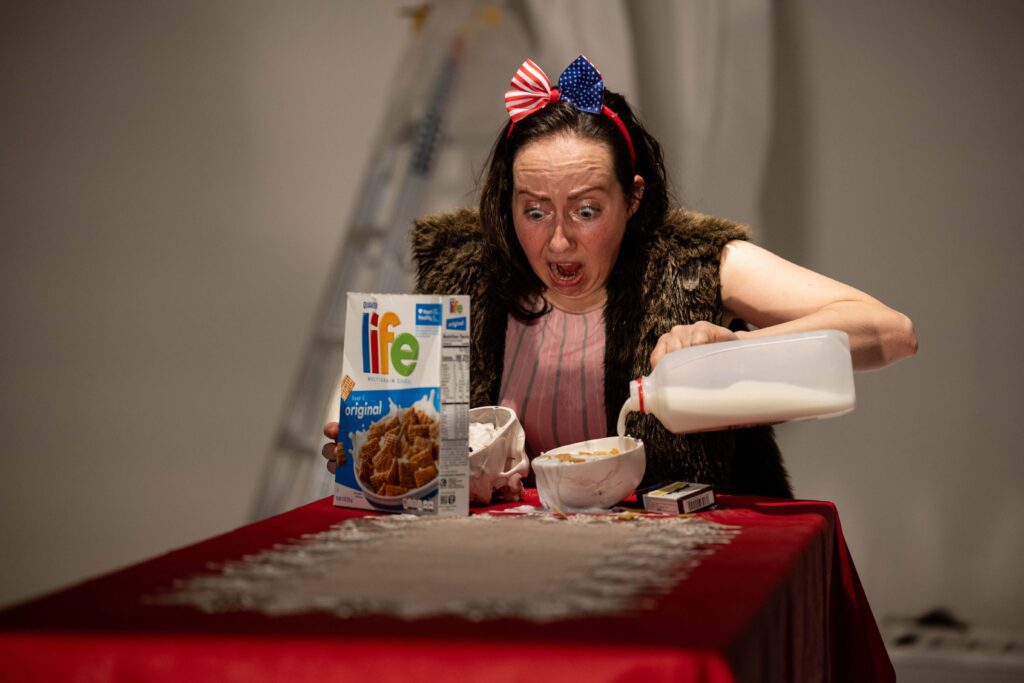
FV: Yeah, it’s really difficult to walk around in a room all by yourself and try to say stuff out loud. Sometimes it can be productive, but sometimes it’s not.
AT: Most of the time it’s not. It’s very unpleasant. I prefer to walk around the city, or bike or go on the subway and talk to myself while I’m in motion. Otherwise, I have a lot of shame, I think that’s what happens. When I rent a studio, or someone gives me a studio and I ‘show up for work’ I just feel like a fucking idiot. Like I’m in this empty room just putting on different costumes while other people are doing ‘real work’. It’s always better for me to work after 5 pm, where I feel like I’m allowed to be an idiot. I was surprised how hard it was having a formal residency at the festival. I mean it’s a luxury, but maybe because of that it was actually difficult. I felt so shy to spend all day screaming and singing stupid songs and wiggling around! That’s maybe where some of the existential parts of the show came from, like ‘What is this?!’ What does it mean to honor a practice of being present and responding and trying to play in a culture that shames you so much for anything that doesn’t look like productive work? If it doesn’t look like productive work, you’re actually a threat to society. To play around is not allowed.
FV: I’ve noticed that you also rework material in your different works, like the character Wilhelm Meister from this book by Goethe, that you were invoking in Sad Boys in Harpy Land. How is the ecosystem between your different works?
AT: That project I consider a sort of lifelong project, where I would continue adapting Wilhelm Meister’s Apprenticeship alongside my own life forever. Now it’s been three episodes: the first was 2014, the second was 2018 and the third was the one you saw in 2023. And I’m trying to decide whether I will continue my lifelong project or abandon it. I’ve been revisiting the Goethe book lately. It’s very interesting because essentially, Wilhelm, this main character who wants to be a theatre artist, ends up quitting the theatre, becoming a businessman and then joining a mystical cult called The Tower Society. And I’m like: “Ok, I can see that happening to me.” What always struck me about the book was that it’s this story from the 18th century about this little German boy, but there were so many parallels to my own life as a young Jewish New Yorker and it just cracked me up and disturbed me that our stories could be in some ways so similar. Now the question is what happens now that I’m in my thirties and Wilhelm is also in his thirties. So, we will just have to see if I also quit theatre and become a businessman and then join a mystical cult…
FV: That would be an unexpected punchline!… As a fellow lover of puns, I’ve noticed that you also deploy puns a lot in your work. What is your relationship to puns?
AT: People don’t usually admit that they love puns. It’s so embarrassing. If I were to get very philosophical about it, I would say that in our culture we disrespect the body. There’s a lot of disrespect for the body, similarly to how the pun is considered really ‘low’ humor, any kind of physical humor is also considered low. And I think there’s a connection between that. We prioritize and we raise up the brain as something separate from the body, but the intelligence of the body is often dismissed. Puns for me are the intelligence of the body at the level of language. Because it’s about the body of the word. The shape of the word. The sound of the word. This weird other associative kind of meaning-making that’s physically in the word. It’s like the word is making a physical joke.
FV: The word is doing drag!
AT: Totally, the word is doing drag, the word is slipping on a banana peel. And people go:”ughh that’s not the kind of knowledge we respect.” But that’s where the real shit is. It’s in the betweenness. People really look away from me when I make a pun. They cover their faces with their hands and groan. They can’t bear it. It’s so interesting. They will give me feedback such as “I love the work, but you gotta get rid of the puns.”
FV: In Sad Boys in Harpy Land there’s also this whole theme of gender and transformation, being a sad boy but at the same time being a woman who’s been turned into a tree. How do you think about gender in your work?
AT: Being a performer since I was a kid, gender fluidity was always very obvious to me. Like how we perform different genders all the time. It can be really fun and illuminating to perform masculinity or to perform femininity and see what you discover inside of that, both onstage and in everyday life. But there is also the reality of being perceived as female and all of the misogyny that female-presenting people encounter on a daily basis. Writing Nothing Doing, in the context of the right to an abortion being taken away by the government here in the US and so much increased misogyny in the national discourse and violence against queer, trans and disabled bodies, I became very aware of this anger in my body. When I would be improvising, this big melodramatic female rage would just come up. And that became a character in Nothing Doing. I was just so angry at abusive dynamics with men in my life, abusive dynamics with institutions, abusive dynamics with the government. This feeling on every level that your bodily autonomy is being taken away. So, then I tried to figure out how to play inside of that, how to find a kind of pleasure inside the anger.
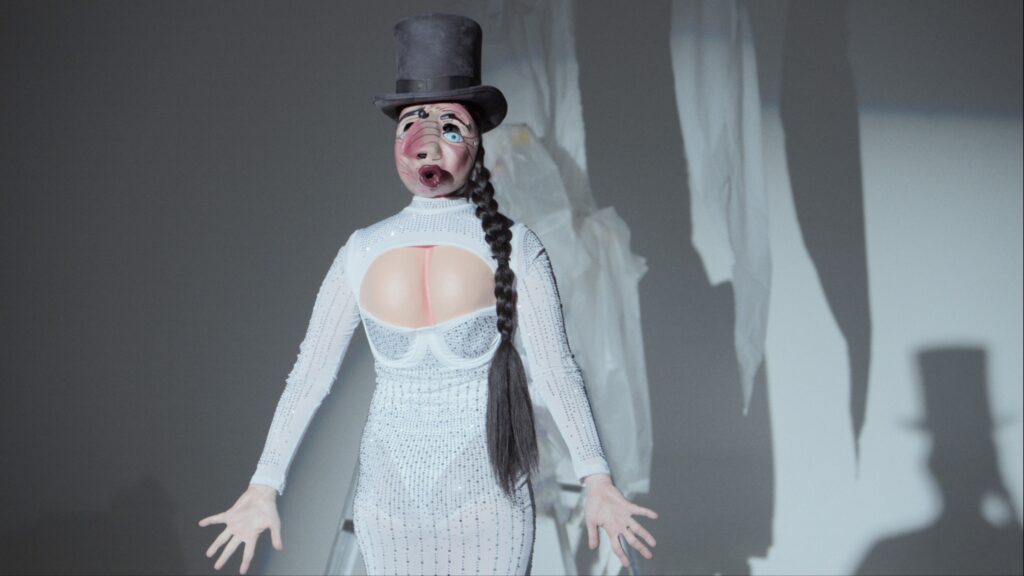
FV: These abusive dynamics with the institutions is also something I often find myself in and try to work around in my praxis, like how do you actually work with institutional critique while being inside the institution?
I really thought for a long time that if you became a really good clown, you could upend these dynamics. I’ve always looked to the model of the Bouffon, a form of grotesque clown that mocks the powerful. In the ideal Bouffon performance, the king and the elites laugh at the Bouffon and reward him for being so entertaining and then they slowly realize they are the ones being mocked and they all kill themselves? So, as a clown you want to entertain and keep your job but also genuinely try to change the unjust structures. But as time goes on, I find myself confronting that it’s been the same power dynamics forever. There’s always been kings (or corporate overlords) hoarding resources. There’s always been artists critiquing the king. So, in a way, my focus is beginning to shift. Maybe I don’t wanna be in those rooms. I’m in those rooms because I need to make money, but I want to prioritize performing in spaces where it’s not about that. It’s not about confronting or insulting the king. It’s about having a really good time with the people.
FV: Yeah, it feels so difficult to change these institutions. I’ve even been thinking about adding clauses to my performances, where the institution also must pay for consultant hours with me and actually make an effort to change these structures that I’m criticizing, instead of just hiring this jester to tell them everything they’re doing wrong, and then just clapping their hands and calling it a day.
AT: It’s really an important thing to think about. Because in a way they’re doing their own ‘performance’, which is the performance that they care and that they’re doing the good thing. I actually tried to put a clause in when I made my piece about clowning and composting, so that any museum that presented it had to start composting their organic waste on site. Then the compost would become my set, and then they’d have to keep the composting protocols in place after the performance. It turned out to be very hard to bring about. So now I perform that piece at community composting facilities instead. And it feels way better. It’s not about criticizing the institution for what they’re not doing, it’s about celebrating these amazing communities that are doing the work. And in my body, it feels better after I’ve done a show at a place like that. But maybe it is about doing both. And still trying to use some clown trickery to make the institution change.
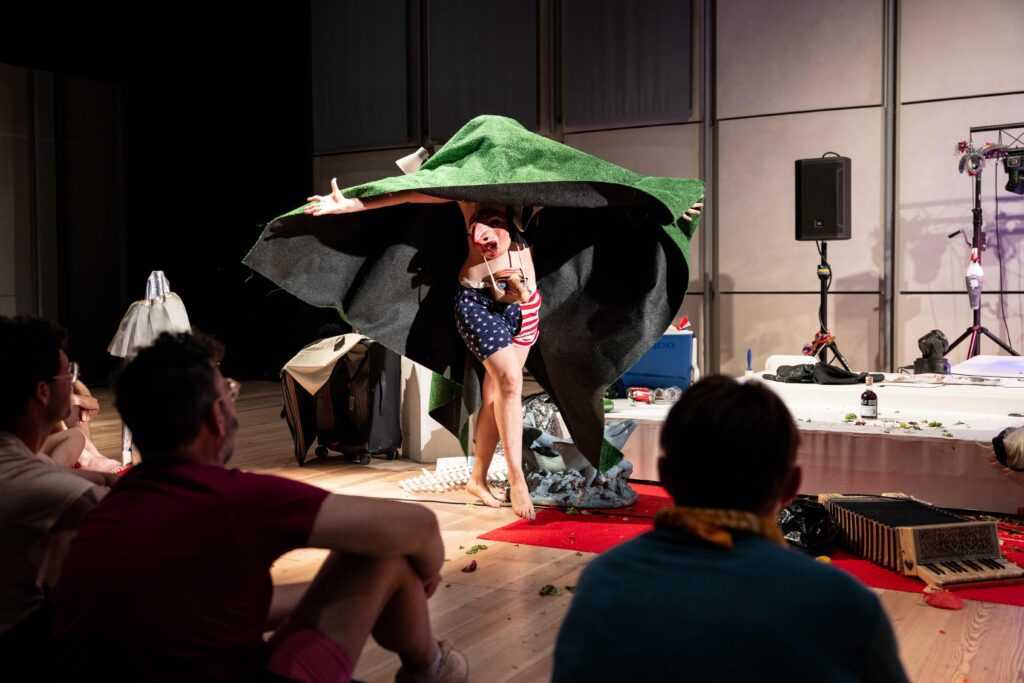
FV: Even though it can feel futile…
AT: That was actually a pun that the amazing clown artist Jenn Kidwell made in her recent show. She was collaborating with a sign language interpreter and she says “it’s futile”, then the interpreter signs back “feudal”? And she’s like, “Yeah, I guess both…”
FV: It feels very fitting to end the interview with a pun. Thank you so much for all your thoughts!
CREDITS FOR NOTHING DOING:
Created & Performed by Alex Tatarsky in collaboration with Shane Riley (music) and Andreea Mincic (scenic, props, costume design) with lighting consulting from Masha Tsimring.
BIO:
Called “a hilarious, finely tuned absurdist” (Theatre Jones) and “vulgar and profane” (NYTimes), Alex Tatarsky makes performances in the uncomfortable in-between zone of comedy, dance-theater, performance art, and deluded rant — sometimes with songs. Tatarsky experienced fleeting fame as Andy Kaufman’s daughter and used to perform as a mound of dirt. Playing with perceptions of language and narrative structure, their live performances are highly responsive to venue and audience, often breaking the fourth wall and embracing humor to reveal vulnerability and humanity. They have presented work at venues including Abrons Arts Center, La Mama, MoMA PS1, The Kitchen, Judson Church, Playwrights Horizons, and The Whitney Museum of American Art — as well as many bars and basements. As curatorial fellow at the Poetry Project, they organized a series on the poetics of rot. They are currently touring solo clown shows: Sad Boys in Harpy Land, Dirt Trip, MATERIAL and Nothing Doing. @tartar.biz
More from Filip Vest
